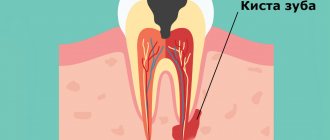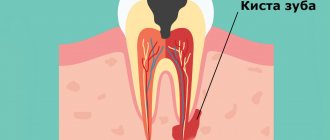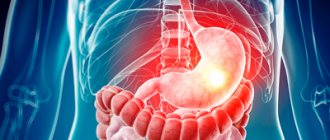Bone grafting is one of the most common dental surgeries. It consists of replenishing the deficiency of bone tissue in the area of the alveolar processes of the upper or lower jaws. The main reason for prescribing this surgical intervention remains dental implantation, which requires the implantation of artificial roots into bone tissue. Much less commonly, bone grafting is performed as the final stage of treatment for a dental or jaw cyst. Also, the operation can serve as a transitional stage, since after removal of the cavity, if the tooth is destroyed, prosthetics are required.
Restoring the volume of atrophied bone tissue is an important manipulation in dental surgery. The gradual resorption of the alveolar ridge leads to the fact that the bone is deformed and its physiological and anatomical correctness is disrupted. This prevents the dentition from performing its functions, and is externally accompanied by aesthetic defects. If we are talking about the consequences of cyst removal, then the thinning can be so pronounced that the bone simply breaks with minimal load. Timely bone grafting allows you to avoid these and many other adverse consequences.
When deletion is indicated
Modern dentistry strives to preserve teeth and their roots whenever possible, but this is not always possible. Dental surgeons remove teeth with cysts for the following indications:
- the infectious process was caused by an advanced form of periodontal disease;
- there is a vertically located crack on the root of the tooth or on itself;
- the dental root canals are impassable, as a result of which therapeutic treatment becomes impossible;
- severe tooth decay, and restoring it does not make sense (too expensive and time-consuming);
- the tooth is located entirely in the cavity of the neoplasm;
- the cyst has grown into the nasal cavity, or the size of the tumor is more than 10 mm;
- the root of the tooth has fused with the neoplasm;
- the tooth is very loose.
The dentist decides to remove a tooth with a cyst after a thorough examination of the patient, which includes examination, history taking, radiography or visiography.
Cystectomy / root apex resection: indications, contraindications and causes
- The appearance of any neoplasm, for example, fibroma or other, larger than 1 cm.
- Incomplete or poor-quality root canal filling in the treatment of pulpitis, for example;
- Stump tab or pin in the dental canal;
- Damage to the root walls during tooth filling;
- Periodontitis, granulomas, cysts, fibromas;
- Perforation of the tooth root, fracture of the root or its apex;
- Curvature of the root canals or the apex of the tooth root;
- Presence of a foreign body;
- Inflammation near the site where the denture is installed;
- A fragment of a dental instrument in the canal;
Contraindications include periodontal disease, periodontitis, and the presence of a tumor at the location of the tooth.
Removing a tooth with a cyst: does it hurt or not?
In the “Optimal Choice” dental clinics, when removing teeth with benign formations at the roots, the latest anesthetics and modern equipment are used. Therefore, patients do not need to be afraid of anything at all. The doctor selects anesthetics on an individual basis; in some cases, general anesthesia may be recommended (we do not use it). Minor pain may occur after tooth extraction, when the anesthesia wears off. To relieve pain, your doctor may prescribe painkillers.
Symptoms of cystic lesions
A characteristic feature of a neoplasm under a wisdom tooth is its latent appearance and development. A person does not even realize that there is a growing cyst until it is accidentally discovered during an X-ray or in the dentist’s chair. Education can also reveal itself during colds, in stressful situations and during periods of winter frost.
As a rule, a trigger is triggered in the form of severe stress or ARVI, which is the catalyst for the purulent process. When the cyst space fills with pus, the patient experiences the following symptoms:
- Painful sensations when touching the affected area;
- Swelling of the face in the area of inflammation;
- Enlarged lymph nodes;
- Body temperature rises;
- Malaise, apathy and lethargy;
If you ignore these symptoms, the disease enters a new phase - flux, osteomyelitis and sinusitis develop. In addition to internal processes, complications can also affect external manifestations - deformation of the dental bite or the appearance of facial asymmetry.
Types of deletion
A dental cyst can be treated using one of the following surgical methods:
- Cystectomy is the most common way to remove cysts on teeth. During this operation, an incision is made on the gum, through which both the benign neoplasm and the apex of the tooth root with pathology are removed. The cystectomy procedure is usually performed under local anesthesia, after which the doctor prescribes antibiotics to the patient.
- Hemisection - this type of removal is used if a tooth with a cyst has more than one root, and at least one of them is pathologically changed. During this procedure, the cystic formation, the root of the tooth with pathology, and part of the tooth itself are removed. After this operation, a crown is placed on the tooth.
- Cystotomy is the most gentle type of surgical treatment for dental cysts, in which the doctor removes only the front wall of the tumor. The tooth body is completely preserved.
These techniques are an alternative to the complete removal of teeth with cysts. But it is not always possible to apply them. To completely remove teeth with benign tumors, the extraction method is used. The operation can be performed urgently or planned.
Treatment of a cyst under an extracted tooth
The neoplasm is treated surgically. An x-ray is taken first. The image shows the area where the capsule is localized, its size, complications, for example, bone melting after rupture of the bladder with advanced pathology.
The doctor removes the cystic sac, cleans the cavity of pus, if there is any, and carries out an antiseptic treatment. When using a laser, the operation is performed practically without blood, and wound healing is faster. In any case, you need to take antibiotics to prevent relapse.
What are the stages of the operation?
The procedure consists of the following steps:
- The desired area is numbed using conduction or infiltration anesthesia.
- The gum is peeled off from the wall using a rasp.
- The tooth is loosened and removed using forceps or an elevator.
- The dental unit is removed from the socket. In difficult cases, the tooth is first sawed into pieces using a drill, and then each of them is removed separately.
- The extracted tooth and socket are examined by a doctor.
- The cyst cavity is cleaned, and the wound is treated with antiseptic drugs.
- The wound is stitched up.
- Using an X-ray examination, the doctor makes sure that fragments, particles of the tooth and the removed tumor do not remain in the jaw.
- Antibiotics, anti-inflammatory drugs and anesthetics are prescribed.
Two to three days after the operation, you need to re-visit your dentist to monitor the condition of the tooth socket.
Advantages of the classical method
The classic protocol involves 2 stages, separated by time:
Implantation of an artificial rod
The implantologist installs a titanium root into the healed and restored socket and closes it with a plug screw. The implant is not subjected to load until complete engraftment.
Prosthetics
After 4-6 months, the doctor places the gum former for 2 weeks. The orthodontist then installs the crown or denture.
The classic two-stage regimen is preferable for patients with cysts because it allows time for:
- complete drainage of the cystic tumor cavity;
- eliminate infection and inflammation;
- bone tissue growth.
After complete treatment, the risks of complications in the early and late postoperative periods are minimized.
Possible complications
Among the common consequences of removing a tooth with a cyst may be the following complications:
- slight increase in body temperature;
- migraine;
- soft tissue swelling;
- toothache.
In order to alleviate the patient's condition, symptomatic treatment is prescribed.
If the doctor is insufficiently qualified or the patient does not comply with medical recommendations, the following complications may arise as a result of surgical intervention:
- infectious process in tissues;
- injury to nerve endings;
- profuse bleeding.
To avoid this, you must contact only trusted dentists with good experience and clinics with modern equipment, and also follow all recommendations given by your doctor.
Diagnosis and treatment
To clarify the diagnosis, the doctor examines the patient. In the early stages of formation, the cyst is not always visible, so an X-ray of the jaw is taken.
There are several methods for treating cysts.
- Drug therapy. Effective at the initial stage, when the cyst is just forming. Aimed at suppressing the inflammatory process, it includes rinsing with antiseptic solutions, taking antibiotics, and local treatment of the affected area of the gums with ointments and gels.
- Surgical intervention. Indicated if the diameter of the cystic formation exceeds 1 cm. During the operation, the doctor can remove the cyst along with the fibrous capsule or install a drainage to drain the purulent contents.
Preventive measures
To ensure tissue healing proceeds faster and serious complications do not arise, a number of recommendations must be followed. Dentists at the Optimal Choice clinic give the following advice to their patients:
- For several days after surgery, rest is required; any physical activity (even light) is contraindicated;
- avoid hot water procedures, including baths, steam baths, saunas, and do not use hot compresses;
- You cannot use active mouth rinses for 2-3 days; if necessary, they can be replaced with oral baths with infusions or decoctions of medicinal herbs (with oak bark, calendula, eucalyptus, sage), furatsilin, chlorhexidine, etc.;
- do not drink alcoholic beverages or smoke for 2-3 days;
- Taking medications prescribed by a doctor is mandatory.
Compliance with these rules, as well as regular visits to the dentist for preventive examinations and at the slightest unpleasant symptoms, will allow you to avoid serious negative consequences and significant financial expenses for dental services.
Experts' opinion
Question: Is it possible to avoid the occurrence of a cyst on a tooth?
Answer : The etiology of the formation of a cyst at the root of a tooth can be different. At the initial stages, treatment of this pathology does not pose a serious problem. Therefore, it is very important to be regularly examined by a dentist, and also to take x-rays or visiography at least once a year to identify any pathologies of the dental system. New growths, if present, will also be visible on the images. To reduce the likelihood of tumors appearing, if any diseases of the oral cavity and nasopharynx occur, it is necessary to treat them in a timely manner: develop the habit of regularly rinsing your mouth with antiseptics, and learn to brush your teeth correctly. Maintaining a healthy lifestyle, a balanced diet, a strong immune system and preventive dental examinations are the key to dental health.
Question: Is it possible to get rid of a cyst on a tooth at home on your own?
Answer : We do not recommend self-medication if you have any pain or unpleasant symptoms in the oral cavity. Any discomfort may be a sign of a serious illness that requires medical attention. If it is not possible to urgently visit the dentist, then to reduce pain you can use the following rinses: herbal decoctions (yarrow, calendula, sage, chamomile, oak bark), a solution of baking soda or salt, vodka, tea tree essential oil. This may help reduce pain, but in any case you should see a doctor as soon as possible.
Why does a cyst appear at the site of an extracted tooth?
The neoplasm is a hollow capsule of dense tissue filled with serous or purulent contents. It occurs as a response of the body to an infection to limit its spread. Thus, the main reason for its appearance is pathogenic microflora.
Provoking factors:
- Tissue infection during nerve extraction or removal. This may be insufficient antiseptic treatment of the surgical field, unsterile instruments, or other doctor’s shortcomings during the procedure.
- The tooth was removed, but the cyst remained. This option is possible if the necessary diagnostics were not carried out and the doctor simply did not notice the pathological formation.
- Dry hole. After extraction, a blood clot is formed, which protects deep tissues from the penetration of bacteria and food debris. If the blood plug comes off or falls out, the opened cavity becomes the center of an accumulation of pathogenic organisms, which become provocateurs of pathology.
- Medical errors during implantation. If the implant is installed soon after removal, infection and capsule formation may also occur during the procedure.
- Failure to follow the doctor’s recommendations during the rehabilitation period. If the patient is negligent about his health, the risk of developing inflammatory processes increases.
Neglecting antibiotic therapy can ultimately cause a purulent infection. A dry socket is formed due to intensive rinsing of the mouth and licking of a blood clot. If the patient smokes or abuses alcoholic beverages, the wound in the mouth does not heal well, which means the risk of complications increases.











